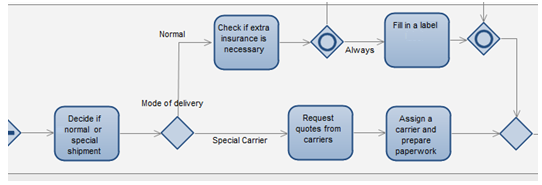Written by Frances Sneddon on Tuesday January 22nd 2013 in CEO and CTO blog, What We're Thinking
BPSIM Interchanging BPMN and Simulation

For the last year a group of BPMN and simulation industry pioneers (including SIMUL8 Corporation) have been working tirelessly to create a new standard, BPSim. This will let simulation information be interchanged between software packages via the existing BPMN or XPDL standards.
What does that mean and why should you care? I’ll try to explain here, it’s actually really simple concept but for some reason really hard to explain simply! I’ll also explain why I think this is a huge step forward for simulation and its general adoption.
What does that mean?
It’s a standard technique these days to map out your process flow. To help everyone be able to share these types of diagrams more easily the BPMN (business process mapping notation) standard was born. Basically it’s a set of rules for how to draw your diagrams to describe your process, a common language. Sandy Kemsley has a really clear article explaining why a common language like BPMN is so needed.
For example a diamond shape always represents a gateway, a decision point, like “Mode of delivery” in the picture below. It’s a step that takes no time and where a decision is made about whether the work should route down one direction or another. If there is a circle inside the diamond icon, then it means it’s an inclusive gateway which means work can be passed to one or more of the exit paths in parallel. Every symbol has its own definition.
The picture below is an example of a BPMN diagram created in SIMUL8 Professional.

BPMN also provides rules for how these diagrams can be expressed in text, in something called xml. You can see a small example below for an end object. I know it looks terribly scary, but don’t worry as an end user you never, ever have to worry about understanding this!
![]()
What the XML allows software packages to do is share the information about your diagram, interchange it. Because it’s just text rather than encrypted like a normal save file, anyone can read it, so any other software package can read it, validate it against the BPMN rules and then work out what it should do with it.
So that means you can export your BPMN diagram from one software package to another. Perhaps because you want to take advantage of the extra features you can get in another tool, like say, you want to take your diagram into a simulation tool to do some process analysis.
So long story short, what the Business Process Simulation Working Group has done is develop is a new standard that can be used alongside BPMN and XPDL (XPDL is similar to BPMN but mostly used in workflow and doesn’t have a visual representation it’s purely XML based) that will allow data needed for simulation to be interchanged in a similar way.
The BPMN schema largely focuses on interchanging the structure and to a small extent the processing rules. The new BPSIM schema focuses on sharing things like timing information, resources to complete tasks and priorities of resources. This is all crucial information for the simulation because with this the simulation can provide real insight into how your process will perform in the real world.
Why should you care?
If you’re a user of BPMN and whether you’re new to simulation or not, this will still ultimately make a big difference for you.
Now you’ll be able to create your BPMN diagram, add in some data points and the simulate it. Whether your BPMN tool has simulation capabilities or not, because if it doesn’t you’ll be able to export your BPMN diagram and bring it into a simulation tool like SIMUL8 that reads in both BPMN and your BPSIM data. So you can have the power of simulation whether or not your BPM tool of choice chooses to support or not.
I care because I think this is a huge sign that simulation is taking its rightful place as a mainstream process improvement analysis technique. Simulation brings so much insight to static process flow diagram analysis, real queuing time analysis, real world randomness, an understanding of how resource priorities can effect their capacity to deliver, and so much more. It’s great to see the BPM world accepting and appreciating the value simulation brings them.
What next?
Well now we need all the vendors, BPM and simulation, to adopt and implement the new standard. Keith Swenson the WFMC chairman has started a campaign on this. That’s when you as the user will get the true benefit, because you’ll be able to set all of us vendors in competition with one another because you can easily move whenever you want to (yes I really did just tell you that!).
What to know more?
Check out the resources below, but as always drop me an email or post a comment, I’d love to know what you think. Can you see this creating a step change in simulation adoption?
BPSIM.org – The official website for the new standard http
The BPMN standard – be warned, not an easy read!
WFMC – the organization behind creating the standard
Our BPMN features – some information on SIMUL8’s BPMN features
 Want to chat simulation? Get in touch!
Want to chat simulation? Get in touch!
Frances Sneddon, CTO SIMUL8 Corporation
frances.s@SIMUL8.com
@FrancesSneddon